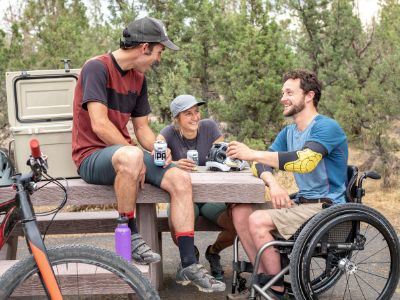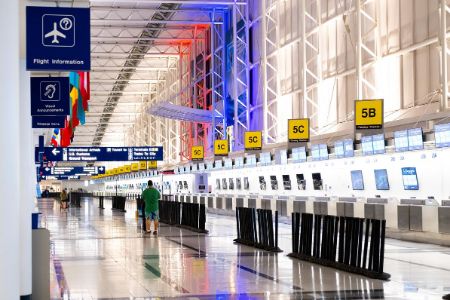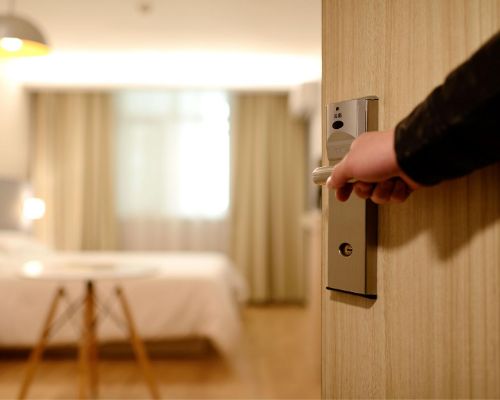“My disability exists not because I use a wheelchair, but because the broader environment isn’t accessible.” - Stella Young
Traveling with a wheelchair may initially seem fraught with difficulty, as the world is not always an easy place to maneuver when you’re living with disabilities - whether you have a wheelchair or not. But as another paraphrased saying goes, “If there’s a wheel, there’s a way”, and we have compiled the best tips from seasoned wheelchair users themselves to help guide others so that everyone who uses a wheelchair can travel with confidence, security, and ease.
Planning is key to successful wheelchair travel
Traveling with a wheelchair requires more preparation and planning than if you were traveling without disabilities, but the extra effort will be more than worth your while and result in a much better experience than learning through trial and error. In this guide, we will cover all the wheelchair travel tips you need to know, including for air travel, hotels, and road trips.

General Tips for Disabled Travel:
- Allow for extra time - All the moving and transferring along with maneuvering around obstacles will tend to take much longer than you think, so be sure to provide plenty of time to get from one destination to another.
-
Positioning - For users that will be in wheelchairs for extended periods of time, consider a reclining or tilt-in-space wheelchair. For more info, check out How does a tilt in space wheelchair differ from a reclining back wheelchair?
- Be prepared - Bring along a current list of your medications with frequency and dosage, contact information for your regular doctor, and any important medical documents, just in case something were to happen to you while traveling. It’s also a good idea to see where hospitals and care centers are located in the areas you’re traveling ahead of time. If you expect bad weather, be sure to have a Sherpa Lined Wheelchair Poncho (if you can't regulate your body temperature) or a Standard Wheelchair Poncho.
- Vehicle prep - If you’re planning a road trip, be sure your vehicle is in good working order and get it serviced and any potential problems repaired before you leave. Know where your owner’s manual, spare tire, and other important car operation components are located, and how to use them. Because GPS and smartphones don’t always work, be sure to keep a road map in your vehicle for every area you will be visiting.
- Ridesharing - If you use a rideshare service such as Lyft or Uber for travel, it’s recommended to order a Lyft Plus or an Uber XL, as these vehicles will have more room to stow your wheelchair.
- Start small - Consider taking a short, trial trip closer to home first before embarking into more involved and lengthy travel. This helps you to see what you may have forgotten so you can be much better prepared for a longer trip.
Packing Tips:
- Start a packing list - Think of everything you will need to bring along and write this down well in advance of the actual day of departure. You can make a list of everything you use in a day or week to ensure you don’t forget any needed supplies.
- Don’t forget comfort - It can be uncomfortable and fatiguing to sit for hours on end. Be sure to bring extra padding or cushions, and a blanket if you tend to get cold, along with neck pillows and travel pillows. Breaking a long road trip into shorter, more manageable days can also be helpful. Consider buying a Giraffe Bottle (Hands-Free Drinking) to ensure you stay hydrated on your trip.
- Stock up - Make sure you are well supplied on any medications, supplements, and other medical supplies and equipment you will need for the duration of your travel. Portable commode chairs, shower chairs, and other assistive equipment you use daily should be packed, along with applicable supplies like blood glucose meters for diabetics, PEG tube enteral feeding supplies, incontinence pads and supplies, ostomy equipment, and portable oxygen.
- Refreshments - Bring along plenty of purified water and healthy snacks to stay hydrated and keep energy levels up. Some people living with disabilities who use wheelchairs will have a tendency to stop their liquid intake before long car rides or airplane trips because they don’t want to have to use the bathroom. While understandable, as various bathrooms, especially those tiny ones on planes, aren’t always that accessible, getting dehydrated presents its own unique set of problems, none of which you want to experience while you’re on a trip!
- Power wheelchairs - While traveling can be fatiguing for anyone, it’s especially exhausting for people living with disabilities. Consider taking a power wheelchair along, especially the models that can disassemble or break down/collapse, as that can help keep you moving when you’re too tired to self-propel. If you are interested in finding the best power wheelchair for you, check out our article: The 5 Best Electric Power Wheelchairs.
- Travel suitcase - Research travel wheelchair options, such as wheelchairs that come with their own wheelchair travel suitcase. This kind of option keeps your wheelchair protected as it goes through baggage handling, a very important point to consider, as so many wheelchairs and scooters are damaged in transit every year.
- Other wheelchair styles - If you’re looking for a wheelchair better designed for travel, ultra-lightweight manual and lightweight folding wheelchairs for traveling provide an easier, lighter, and more maneuverable alternative to larger wheelchairs. They fold down into smaller dimensions to fit easily in most vehicles as well. If you are interested in buying a lightweight wheelchair for your travels be sure to read our article, The 5 Best Lightweight Wheelchairs.
Airplane Travel Tips for Wheelchair Users
Traveling by plane with a wheelchair requires even more intensive planning and preparation. There are things you will need to do when purchasing your ticket, before you get to the airport, while it’s also important to know what you’ll need to do once you’re there, and how to board the plane. While it all seems quite complex, a little consumer information can help make your next flight far more accessible, comfortable, and simplified.
Probably the most important aspect to ensure a smooth flight with a wheelchair is to learn the law so you know what to expect on your flight. The Air Carrier Access Act (ACAA) is the actual law that covers access on all flights to and from the USA, and not the better-known ADA (Americans with Disabilities Act). If you have access-related questions, you can also call the disability hotline operated by the US Department of Transportation at (800) 778-4838.
If there are any access-related problems once you take your flight, ask to speak to the Complaints Resolution Official (CRO), as this airline employee is able to resolve access-related issues on the spot and is specially trained by the ACAA.

Airplane Travel Tips - Before you fly
- Airport wheelchair or your own wheelchair - If you would like to travel with your own wheelchair, be sure to let the reservation agent know what type of wheelchair you have, as passengers using battery-powered wheelchairs must arrive at the airport at least one hour prior to normal check-in times. If you’d rather use an airport wheelchair, request that when you book your flight. Let the airline know you have a disability when you make your reservation.
- Type of assistance - If you’ll require guided assistance and/or wheelchair assistance, it’s important to let your agent know at the time of booking your flight to ensure the help is there where and when you need it. Confirm these necessity requirements with every airline involved in your travel.
- Seating preferences - When you’re booking your flight, also request a seat with a flip-up armrest to make transfers from the wheelchair to your plane seat easier. If bulkhead seating is preferable to you, be sure to ask for that, as not every airline routinely reserves bulkhead seats for wheelchair users.
- Wheelchair instructions - If you’re using your own wheelchair for air travel, be sure to attach clear and concise assembly and disassembly instructions in both English and Spanish. The ACAA requires that if a wheelchair or scooter is disassembled for transport, it must be correctly assembled before being returned to the passenger.
- Time - Along with battery issues on power wheelchairs, it’s also important to allow ample time to mobilize through the airport, use the bathroom, and for all the other check-ins along the way. For a person living with disabilities, it is much better to have too much time at the airport rather than have to try to rush around and potentially incur an injury.
- Comfort - Be sure to wear comfortable clothing that’s loose-fitting, bring a small pillow for comfort, or even use the cushion from your wheelchair for a softer plane seat. Stay hydrated and keep your blood sugar in normal ranges by eating small, healthy snacks.
Airplane Travel Tips - At the airport
- Arrival - Get to the airport as early as possible to ensure you have plenty of time to check-in, find your assistive connections, check baggage, go through security, and board the plane. Most veteran wheelchair travelers recommend arriving 3 hours prior to your boarding time. Ask for a destination tag for your wheelchair when you check-in.
- Self-identify - As soon as you get to the airport, you’ll need to self-identify as a passenger requiring assistance with airline personnel. Even though they may have notated in your reservation that you require aid, they won’t know you’re the person requiring help if you don’t identify yourself as such.
- Transporters - Transporters are airport personnel who can help push your wheelchair and get you through the airport. If you check your wheelchair, you can also rent a buggy/cart that transporters will assist with pushing.
- Security - Once you arrive at the airport, you’ll need to go through airport security. If you're unable to walk through the metal detector, alert the Transportation Security Administration (TSA) so they can hand-wand you and give you a manual pat-down. You can ask for a private screening with a companion present, and you should let the agent know if you have any tender or sore body areas before the screening. It’s important to know that if you have any pre-trip questions or concerns about the security screening process, you can contact the TSA Cares Hotline at least 72 hours prior to your flight. You have the right to remain in your own wheelchair under ACAA guidelines, as long as it has non-spillable batteries until you get to the gate. TSA agents will attach an inspection tag once the security process is completed.
- Boarding gate - Advise boarding gate personnel about any specific assistance you’ll require, such as pre-board, help with carry-on luggage, or mobilizing within the airplane. If you choose to stay in your own wheelchair until you get to the gate, your wheelchair will be taken from you and sent to checked baggage and returned to you at the gate once you arrive at your destination. If you are unable to walk, you will be transported to your airplane seat with an aisle chair, and transferred from that chair to your airplane seat.
- Wheelchair - Remove all the detachable parts of your wheelchair and ensure your identification and destination tag is attached with any assembly/disassembly directions. Inspect your wheelchair once you get it back at your arrival gate to ensure there’s been no damage and that it's working properly. Report any problems immediately.
- In-flight - Notify the flight crew of any assistance you’ll require once you get to your connecting city or destination. It’s also important to remember that wheelchair users requiring assistance in getting off the plane will be helped after all other passengers have deplaned. It’s important to allow for this extra time when making connections, or when making arrangements for ridesharing or shuttles.
Hotel Travel Tips for Wheelchair Users

For wheelchair travelers and others living with disabilities, the importance of finding an adequately accessible hotel room cannot be overstated. Like a home away from home, hotel rooms must accommodate a variety of activities from relaxation and sleep to personal and medical care. Because people living with disabilities are so often reliant on the adaptations made to their homes, it can be difficult to know if a hotel will offer that same level of needed accessibility.
Here is the most important information for wheelchair travelers and others traveling with a disability to find the best accessible hotels to meet their needs. The most important caveat to remember is that just because a hotel says a room is accessible, it still might not meet your specific needs. Experienced wheelchair travelers recommend doing your homework to prevent any access hassles once you’re in the room.
- ADA requirements - Establishing a series of accessible design requirements pertaining to the construction of hotels and other lodging facilities, most of the regulations from the Americans with Disabilities Act of 1990 (ADA) remain in place today, with a few that were updated in 2010 to promote greater accessibility. Developed to protect people of all abilities, and not only wheelchair users, accessible hotel design requirements cater to a diverse array of disabilities. Demanding adherence to a specific set of accessibility features and design principles that can be applied to all types and sizes of guest rooms, three primary components should be available across ADA guest rooms in every hotel. These include roll-in showers with a seat, bathtubs, and bathrooms with grab bars, and communication equipment for the sight and hearing-impaired. The hotel services and amenities that are offered to able-bodied guests must also be made accessible to people living with disabilities, including shuttle services, swimming pools, and spas.
- Booking a room - ADA regulations also cover room reservation rules for hotels in regard to their guests with disabilities. One of these rules states that hotel personnel must describe the room in enough detail so potential guests can determine if it will meet their unique accessibility requirements. Ask for photos and dimensions, and be sure to measure your wheelchair to ensure you can navigate it within the room, especially the bathroom. Because there is no standardized bed height for hotels recommended by the ADA, ask for the height of the bed from the floor, to ensure you’ll be able to transfer to and from your wheelchair. Overbooking of ADA rooms is prohibited, so once you reserve the room, it has to be available on your arrival.
Frequently Asked Questions
How do I travel when disabled?
Planning, research, and preparation will greatly improve the travel experience for people living with disabilities. Using as much advance notice as possible, call ahead to airlines, cruise ships, and hotels to discuss your disability and special requirements, using as much detail as possible. Discuss the trip with your doctor, and take along extra medications, along with all of your medical and health information. Consider contacting a specialist travel agent or wheelchair accessible travel agent to help you navigate the process, as these people often have much experience with disabled travelers.
Do airlines charge for wheelchair assistance?
No, airlines don’t charge for wheelchair assistance, as the 1986 Air Carrier Access Act (ACAA) requires them to provide free wheelchair service to any traveler who asks for it, without needing documentation or description for that need.
How do I request wheelchair assistance? How does wheelchair assistance work?
In reference to airport and airline wheelchair assistance, it’s best to call ahead of time, when making your flight reservation, to alert the airline of your specific wheelchair needs. You’ll need to determine if you’ll be using your own wheelchair or would rather use airport transport chairs, and let airport personnel know whether you’ll need a transporter to push your wheelchair if you don’t have a traveling companion to assist you. Narrow aisle transfer chairs will take you from the boarding gate to your airplane seat, and will also be used for you to deplane.
Summary
As travel by people living with disabilities is on the rise, the travel industry is becoming much more aware of the special needs of travelers with disabilities by providing greater accommodation and added services. Also known as accessible travel or disabled travel, the available information generated by travelers with disabilities grows daily, providing others with valuable insights that can make the difference between an enjoyable travel experience, or a horrible one.
We’ve compiled the best of this information in this article, sharing the most important tips from experienced wheelchair travelers, in order to help you make your own informed travel plans and decisions. From general tips about traveling with a disability to more specific tips about airline and hotel travel, we answered your questions about every aspect of wheelchair travel and your travel wheelchair concerns so your next trip is the best one yet!
Check out more educational resources about wheelchairs and accessible living with our Caregiver University platform, and find a wealth of information about tools for the job of living at our RehabMart YouTube Channel!
Author:
Hulet Smith
Co-founder/CEO of Rehabmart, Pediatric Occupational Therapist, husband, and father. Passionate about connecting special needs kids with superb nutrition, sensory integration, and complementary health strategies. Excited about Rehabmart's mission to become the premier online educational platform which empowers caregivers by spotlighting innovative devices and interventions to achieve optimal patient response and recovery.
Meet all of our experts here!
 Written by Hulet Smith
Written by Hulet Smith



